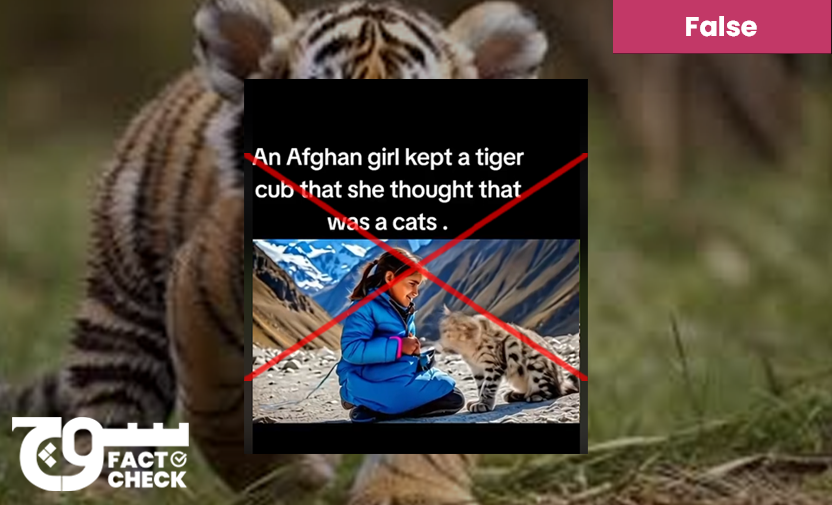
Claim: A video from the Pamir mountain range in the Badakhshan province of Afghanistan shows a child playing with a white tiger she raised from birth.
Fact: The video in question is AI-generated and does not depict a real scenario.
A video allegedly showing an Afghan child playing with a tiger cub has been going viral on social media since early April. The video claims that she raised the cub from birth because she thought it was a cat. The caption reads:
“An Afghan girl kept a tiger cub that she thought that was a cats .
That’s is now a big snow leopard.
That Afghan girl still visits the mountain of Pamir Badakhshan and playing with her friends
#animals #Leopards #Afghanistan #Afghan -Kabul #tigers”
\White tigers are believed to be extinct in the wild, and no tiger species are native to Afghanistan. According to the International Fund for Animal Welfare, “the last known wild white tiger was killed in 1958.”
The claim likely confuses a tiger with a snow leopard, which is native to the region.
Fact or Fiction?
The video bears the hallmarks of AI generation, such as physics-defying movements, inconsistent interactions between objects, and nonsensical sequences.
AI algorithms, particularly deep learning models, can generate realistic images and videos by learning patterns from existing data. These models use neural networks to create content that mimics real-world scenes, even though the underlying scenarios may be entirely fabricated.
In videos, artefacts manifest as flickering, blurring, or sudden changes in texture. In AI-generated videos, these artefacts can occur due to imperfect training or limitations in the model. In the video, the “tiger” exhibits morphing behaviour, including flickering, blurring and sudden changes in texture, especially its face. These inconsistencies are a telltale sign of AI-generated content.
PC Magazine notes a video is likely AI generated if it depicts physics-defying movements, inconsistent interactions between objects, and nonsensical sequences. The video in question has obvious artefacts falling under all three categories.
AI-generated videos often defy the laws of physics. Objects may move unnaturally or interact in ways that would be impossible in reality. For instance, if a creature’s size changes abruptly or if it exhibits movements inconsistent with its weight or physical properties, it’s likely an AI creation. Throughout the entire video, the “tiger” morphs irregularly, indicating poor quality control. At the 7-second mark in the video, the girl’s arm morphs into her body, disappears, and then reappears—an inconsistency in object interactions.
Furthermore, AI-generated videos may contain sequences that make no logical sense. These sequences result from the model’s lack of understanding of real-world constraints. In the video, the girl and the “tiger” change in size and appearance between different shots, creating a nonsensical narrative.
Soch Fact Check debunked a similar claim earlier, when AI-generated images of a Northern Pakistani girl posing with a snow leopard went viral. The image’s creator admitted to using an AI program, Midjourney, to create the image, which had no basis in reality.
Virality
The false notification has received thousands of views on social media and was posted to various social media platforms dozens of times. Soch Fact Check found the notification published on Instagram here, Tiktok here and here, Youtube here, here and here, and Facebook here, here, and here.
Conclusion: The image and video is AI-generated and does not actually show an Afghan child with a tiger.
—
Background image in cover photo: Adobe Stock
To appeal against our fact-check, please send an email to appeals@sochfactcheck.com
